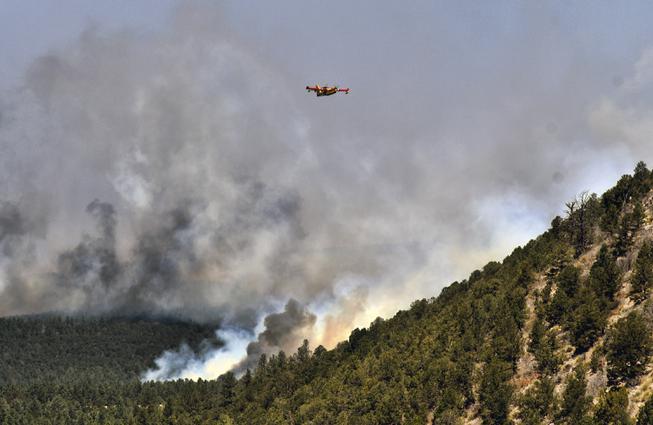
Thomas Peipert) / AP
A firefighting plane flies over a plume of smoke near Las Vegas, N.M. on Wednesday, May 4, 2022. The fire has torched 250 square miles (647 square kilometers) over the last several weeks.
Published Wednesday, May 4, 2022 | 8:08 p.m.
Updated 50 minutes ago
LAS VEGAS, N.M. — Firefighters slowed the advance of the largest wildfire in the U.S. as heavy winds relented Wednesday, while President Joe Biden approved a disaster declaration that brings new financial resources to remote stretches of northern New Mexico devastated by the blaze.
U.S. Rep. Teresa Leger Fernandez announced the presidential disaster declaration during an evening briefing by the U.S. Forest Service about efforts to contain the fire, which has fanned out across 250 square miles (647 square kilometers) of high alpine forest and grasslands at the southern tip of the Rocky Mountains.
“It will help us do that rebuilding and it will help us with the expenses and the hardship that people are facing right now,” the congresswoman said. “We’re glad it happened this quickly.”
Fire bosses said they are seizing upon an interlude of relatively calm and cool weather to keep the fire from pushing any closer to the small New Mexico city of Las Vegas and other villages scattered along the fire’s shifting fronts. Airplanes and helicopters strategically dropped slurries of red fire retardant from the sky, as ground crews cleared timber and brush to starve the fire along crucial fronts.
Bulldozers for days have been scraping fire lines on the outskirts of Las Vegas, population about 13,000, while crews have been conducting burns to clear vegetation along the dozer lines. Aircraft dropped more fire retardant as a second line of defense along a ridge just west of town in preparation for intense winds expected over the weekend.
Local law enforcement officials urged residents to be careful not to spread misinformation. Las Vegas Police Chief Antonio Salazar said his officers would provide “burglary patrols” of evacuated areas and help maintain order at a local Walmart as people line up to purchase supplies.
Meanwhile, numerous fire engines and crews remained stationed Wednesday on the western edge of town.
Getting the right resources into the right areas when they can do the most good is the goal, fire officials said.
“And the chess board keeps getting bigger. That makes it even more complicated,” fire information officer Andy Lyon said Wednesday, referencing a peak and ridge on the northern end of the fire that weren’t factors just days ago. “So now that topography is part of our equation, part of the chess board.”
The fire grew to 250 square miles (647 square kilometers), with containment stuck at 20% of its perimeter. In one area, the fire was about a mile (1.6 kilometers) away from Las Vegas on Wednesday, but the real concern were the gusts of 60 mph (96 kph) or more that were expected to sweep over the area during the weekend.
Officials at Los Alamos National Laboratory were warily tracking another wildfire that crept Wednesday within about 5 miles (8 kilometers) of facilities at the U.S. national defense laboratory based in Los Alamos.
Fire crews worked to widen a road road that stands between the fire and Los Alamos while clearing out underbrush and treating the area with fire retardant.
“Currently, we feel confident that our mitigation measures will protect Laboratory property,” said Rich Nieto, the laboratory’s wildland fire manager in a statement.
Wildfires have become a year-round threat in the drought-stricken West — moving faster and burning hotter than ever due to climate change, scientists and fire experts say. Fire officials also point to overgrown and unhealthy forested areas where built-up vegetation can worsen wildfire conditions.
Nationally, the National Interagency Fire Center reported Wednesday that a dozen uncontained large fires have burned about 436 square miles (1,129 square kilometers) in five states, including New Mexico. More than 3,500 wildland firefighters and support personnel are assigned to fires burning across the country.
While evacuations have yet to be ordered for the town, many residents are packed and ready to go and local school districts have canceled classes. An estimated 15,500 homes in outlying areas and in the valleys of the Sangre de Cristo Mountains that border the town have been affected by mandatory evacuations.
Martina Gonzales and her grandson watched Tuesday from their front yard as aircraft disappeared into a giant plume of smoke to fight the growing wildfire. Four-year-old Lukas yelled “airplane” every time one flew overhead in the effort to save Las Vegas, a commercial hub for the rural farming and ranching region.
Gonzales’ car was packed with valuables in case an evacuation order came, but she was not sure where they would go.
The tally of homes destroyed by the fire stands around 170.
On the northern flank of the big New Mexico fire, authorities said fire lines have kept the flames from crossing the towns of Cleveland and Mora.
The fire merged last week with another blaze sparked in early April when a prescribed fire set by land managers escaped containment. The cause of the other fire remains under investigation.
___
Montoya Bryan reported from Albuquerque, New Mexico. Associated Press writers Paul Davenport in Phoenix and Morgan Lee in Santa Fe, New Mexico, contributed to this report.

